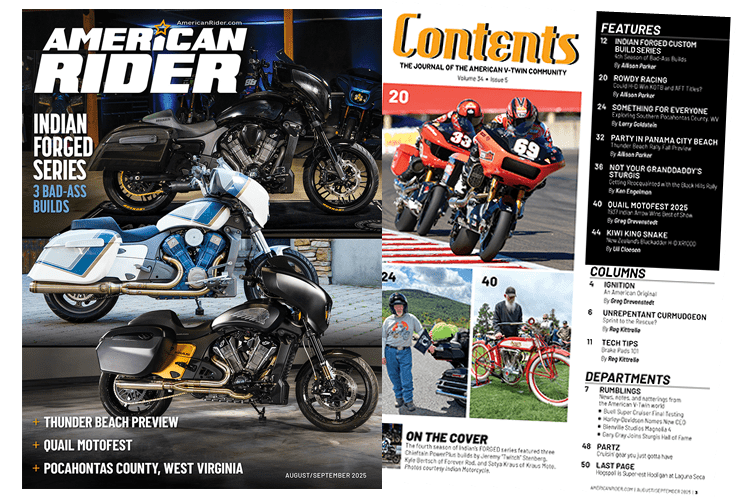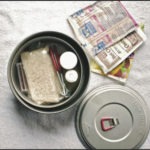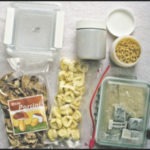Gourmet road fare— the old school way
Have pan, will travel
Roasting marshmallows and hot dogs over an open fire. Munching on a bag of trail mix while sipping a hot cup of herbal tea. This might be your concept of a camp meal, but at my next campsite, I’ll be whipping up Potato-Pasta Paradiso or risotto with wild mushrooms and cracked black peppercorns.
Cooking on the road is not complicated, but success involves a bit of forethought, mainly due to the lack of refrigeration and rough travel. A friend of mine wrote Manifold Destiny, a book about cooking on top of a car manifold while driving. While not quite as severe as the top of an engine, the temperature in a black saddlebag while riding across the badlands of South Dakota in August can bake an egg or turn a block of cheddar into a gooey mess. I tend only to pack food that can survive days of hard travel, although there is more leeway when simply going camping for the weekend. Generally speaking, if it needs to be refrigerated or is fragile, it’s just not going to work.
There are two basic approaches to creating delicious meals while on the road: 1) packing staples, condiments and scrounging for the primary ingredients during the trip or 2) preparing preplanned meals in your home kitchen. The first is the most fun; the latter, the easiest.
Time- and travel-proven ingredients include rice, pasta, kasha and corn meal (polenta). Many gourmet ingredients like sun-dried tomatoes, pesto, garlic and anchovies can be purchased in toothpaste tubes. Tomatoes, wild mushrooms and even black olives are sold dried. Condiments such as ketchup, mustard, peanut butter, honey, jam, soy sauce, sweet and sour and so forth can be saved from restaurant forays and used when camping. Oil is best stored in a secure plastic bladder that is then sealed in a zip-lock bag. Salt, pepper and an amazing array of spices can be carried in small, special containers made for this purpose. If you don’t mind carrying small cans, you have options that range from spam to caviar. I do suggest double-bagging everything. Pack a zip-lock bag for your collection of condiments, another for the containers of spices and still another for the rice and pasta staples. All of these bags go into another waterproof heavy zip-lock or sealed vinyl bag before being placed in your saddlebag or strapped onto the pillion.
Soups are basic simply because they are quick and easy to prepare. Soup stock can be made from bouillon cubes—miso, chicken, beef, onion, vegetable, mushroom and pesto—and rice or small pasta can be pre-measured. Once the broth is prepared, just add beef jerky, chopped hard sausage, dried vegetables and seasoning and simmer. This provides a quick, sustaining meal using a very basic set of cooking gear. These ingredients can be premixed and packaged at home or carried individually to create a variety of soups while on the road.
Risotto is easy to prepare, but the results can be especially gourmet. It’s versatile, since almost any ingredient can be added, but keep it simple because the best risotto has only a couple of ingredients besides the rice and broth. Begin by using a shallot with mushrooms or corn or lobster or something else discovered during your day of traveling. Expand by experimenting with different combinations of ingredients (lobster and corn, scallops and asparagus, etc.) Other than having enough warm broth on hand, there are no set proportions for risotto, except in fancy cookbooks.
Entire cookbooks have been written about potatoes so deciding how to prepare spuds depends upon the cookware and condiments available. For the meat-and-potato type of rider, consider salt pork or hard sausage, as both last for days without refrigeration.
Camping is not synonymous with roughing it. Gourmet camp meals are as easy to prepare as ordinary fare. The difference in cost between my fancy outdoor dinner and a basic restaurant meal will pay for enough gasoline to cover hundreds of miles of road. Besides, at the end of a long day and a great meal, I can always open a miniature bottle of Grand Mariner, kick back and enjoy the million-dollar view from my chosen campsite. Just wish I had some ice.
Recipes from Kenzo’s kitchen
Pease Porridge Hot—I’ve traced the origins of this recipe back to Medieval England, but learned it as a child in New England.
Equipment: Basic one-pot with cover. Liquid-fuel stove.
Ingredients: Water, split peas, shallots (substitute: 1 tbsp. onion flakes = 1/4 cup minced fresh), carrot, salt-pork (substitute: hard sausage or dried bacon bits), olive oil, salt and pepper.
The quickest way is to lightly sauté sliced shallots and add the split peas, stirring slowly to coat with oil and lightly sauté. Split peas and dried onion flakes can be simply added to boiling water but it will take longer for the peas to cook. When the cooked peas become stew-like, add diced carrot, diced salt pork—or hard sausage or dried bacon bits—and continue to simmer until individual peas are nothing more than unidentifiable lumps in a green sauce. Season, cool slightly and serve.
Hungarian Potatoes—Although called “Hungarian,” I modified this from a recipe found in an old Polish scouting book.
Equipment: Pot and fry pan with cover. Liquid-fuel or canister stove.
Ingredients: Water, a couple of potatoes, shallots, tomato paste, salt, olive oil and (optional) hard sausage.
Cut potatoes into chunks, boil in salted water until half-cooked (i.e. still firm), drain but retain some of the water. Dice shallots and sauté in an 8-inch pan. Add the potatoes, stirring to coat with oil and shallots. Add the optional sliced sausage. Stir in tomato paste and a little bit of the potato water. Cover and simmer until potatoes are fully cooked (i.e. inserting a fork into a potato causes it to break apart), then serve.
Kenzo’s Potato-Pasta Paradiso— Adapted for the road from a traditional Tuscan recipe, this is a simple, but elegant, entrée.
Equipment: Two stackable pots and a cover. Liquid-fuel or canister stove.
Ingredients: Water, a large potato or several small new potatoes, pasta (any type), pesto, parmesan cheese, salt and fresh ground black pepper.
Peel a large potato (I often leave the skin on for russets) or use tiny new potatoes, unpeeled. Cut into small 1/2-inch squares (quarter new potatoes). Add salt to water and boil potatoes in the lower pot. Boil pasta in pot #2. Meanwhile, grate some cheese, perhaps 1/4 cup. When the potatoes and pasta are done, drain both, but keep some of the potato water in a cup. Combine the potato and pasta in the largest pot. (I sometime add a tiny bit of olive oil and gently turn—a folding mix motion—to coat the potato and pasta.) Add pesto, 3/4 of the grated cheese, and gently mix by turning with a spoon. Add a little of the potato water to prevent clumping. Add coarse sea salt mix and serve. Top with the last 1/4 cup of grated cheese and add ground black pepper to taste.
Traditionally, the potatoes are cooked in one pot until done and the pasta is cooked in a second. On the road I often use a single pot, adding the pasta when the potatoes are half cooked, but this method takes practice. Pesto can be prepared at home or purchased in a tube. This can be thinned as need with a little olive oil, and extra garlic can be added from a tube or a minced raw. I generally carry small pasta like Noodle-Os; but dried tortellini, farfalle, twist and penne work better.
Mushroom Risotto—Once the principals of making risotto are learned, the combination of ingredients is practically endless and it becomes adaptable to foraging. Fresh asparagus, milkweed, nettles, corn, fish, scallops and much more can be substituted.
Equipment: Two pots or one pot and a deep pan with a cover. Liquid-fuel or canister stove.
Ingredients: Water, rice, parmesan cheese, shallots, dried mushrooms, olive oil, salt and pepper.
Boil water, add mushrooms, remove from heat, cover and let stand for 30 minutes. Drain, but consider keeping the water. (If using other dried vegetables, they should be soaked at this time. Fresh mushrooms, tender milkweed leaves and other delicate ingredients should be cleaned but not cooked.)
Make a broth using bouillon cubes and set aside to cool. Chicken works well, as does mushroom. The water used in soaking the dried mushrooms can be used if desired. Ratio of water to rice is 2.5:1. Grate the cheese and place on a dish or pan cover until it is needed.
Mince the shallots and sauté them in a deep pot that will be used for cooking the rice. (If you are going to include fish, lobster, scallops or something else that has to be cooked, they should be sautéed at the same time as the shallots.) When the shallots become translucent, scoop them out onto a plate, leaving the olive oil in the pan. Add the dry rice, stirring constantly over low heat for about 5-7 minutes or until it turns a light gold color. Add the shallots (and any other cooked ingredients), stir, then immediately add a little of the warm broth. Keep stirring! When the broth is absorbed, add a little more and keep stirring! When the rice no longer absorbs any more broth, stir in the cheese (and any delicate ingredients like milkweed or fresh corn), remove from the heat, cover and allow it to sit for 2-3 minutes. Add fresh pepper or salt to taste. To really make a statement, add a little bit of grated black truffle to the risotto before putting the cover on the pot.


















